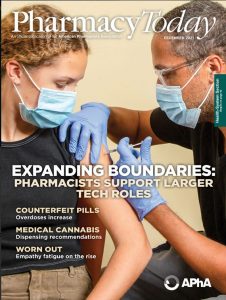The following article appeared in Pharmacy Today with our Chief Medical Officer Dr. Jason Barrett. The full article is below and more information can be found at: https://www.pharmacytoday.org/article/S1042-0991(21)00935-X/fulltext
People with disabilities experience significant barriers when accessing medications and even basic health care. While this is nothing new for those living with a disability, the pandemic has brought many of these challenges to light.
A recent CDC study found that Americans with a disability were more likely to seek COVID-19 vaccination but had more difficulty obtaining them compared with other people. The survey study, which included nearly 57,000 people from May to June 2021, revealed that unvaccinated people with a disability—problems with vision, hearing, or walking, for example—were nearly twice as likely as unvaccinated people without a disability to say they would definitely get vaccinated. However, among individuals aged 50 to 64 years, 63% of people with a disability had received COVID-19 vaccine doses compared with 72% of other people.
While the study findings described the overall challenges with vaccination access for this population, W. Thomas Smith, PharmD, JD, said it also brings up an important point about communicating necessary information about the COVID-19 vaccination to those living with disabilities.
“The disability population is not monolithic,” said Smith, who is dean of pharmacy and graduate life sciences at Manchester University in Indiana and has himself lived with a physical disability. “There are a variety of disabilities. Therefore, it is important to ask whether the information being presented accommodates all types [of disabilities], including cognitive, physical, sensory, or intellectual disabilities. Mitigating the information barrier is a first step.”
As one of the main resources for information on COVID-19 vaccination and other important health care education during this time, pharmacists need to understand the barriers people with disabilities face, including issues with transportation, technology, and support services such as American Sign Language interpreters.
About 15% of the U.S. population identifies as being disabled. However, Smith said many disabilities are hidden. “It’s likely you [as a pharmacist] are interacting routinely with someone who has a disability—some disabilities may not be as visible as others,” he said.
Blind and low-vision patients
Staff at Accessible Pharmacy Services for the Blind often tell their patients that if they don’t have a solution for them at that moment, they can be a resource. The specialty pharmacy, which caters to the blind and low-vision community, has been in operation since April 2020. The pandemic showed them the necessity of specialized services for this segment of the population, which experiences heightened levels of inaccessibility and lack of inclusion in most daily activities.
A long-standing problem has been labeling and packaging, which the pharmacy has worked hard to resolve and continues to expand upon. The company has blind ownership and blind staff who contribute to patient-centered solutions.
Jason Barrett, PharmD, Accessible Pharmacy Services for the Blind chief medical officer, noted that no blind person’s story is the same, nor is their experience. Some individuals are born blind, some develop it from an accident, and others develop blindness from a wide range of health issues. For example, as more people develop diabetes, diabetic retinopathy is becoming more common.
Abilities range widely, too. For instance, only 10% of blind individuals know braille. And while technological solutions may help some individuals, they are not for everyone.
“What we realized is that we needed to provide a comprehensive look at this,” said Barrett.
Accessible Pharmacy Services for the Blind provides more than prescriptions, home delivery, and medication therapy management. Partnering with other organizations to provide larger solutions is a big part of what they do.
“Our patients are driving the growth of our business,” said Barrett. “We always ask them what other services we can provide to help them.”
Take it a step further
Even though pharmacists are busier than ever during this time, their services have largely gone uninterrupted and pharmacies continue to be the place where patients can speak directly with a health care provider.
“There are a host of other barriers with access and the like that individuals with disabilities could face getting a vaccination or other health care service,” Smith said.
Smith also encourages pharmacists to help patients with disabilities know where they can get a COVID-19 vaccine—or others—if they can’t provide one in the pharmacy.
Taking it a step further, pharmacists can help the person schedule a ride to their appointment, for example.
“What I often tell students is don’t make assumptions about patients; meet them where they are,” said Smith. “Ask them important questions and drill down to be most helpful to them. I invite pharmacists to think outside the box.”
